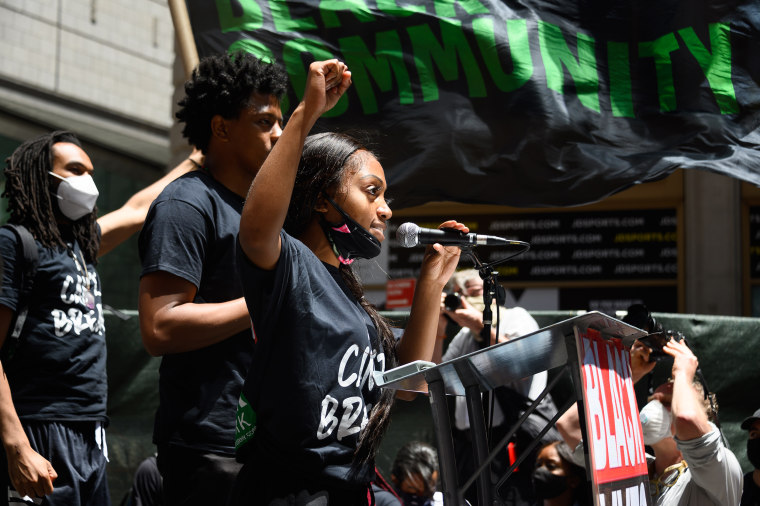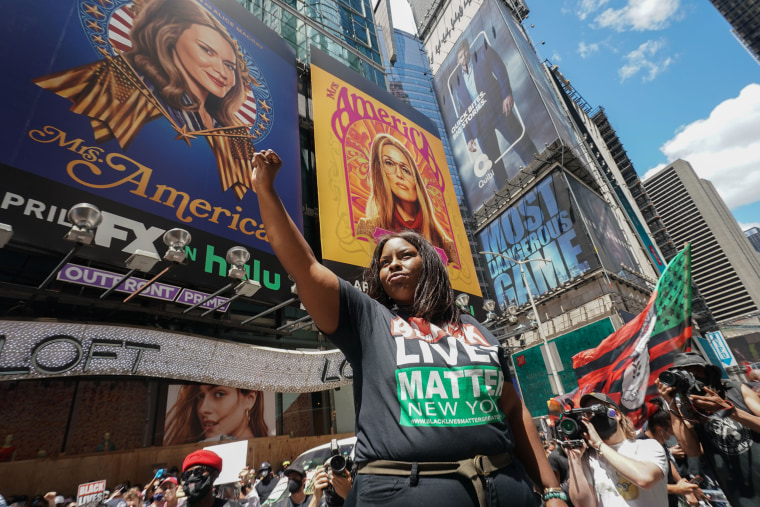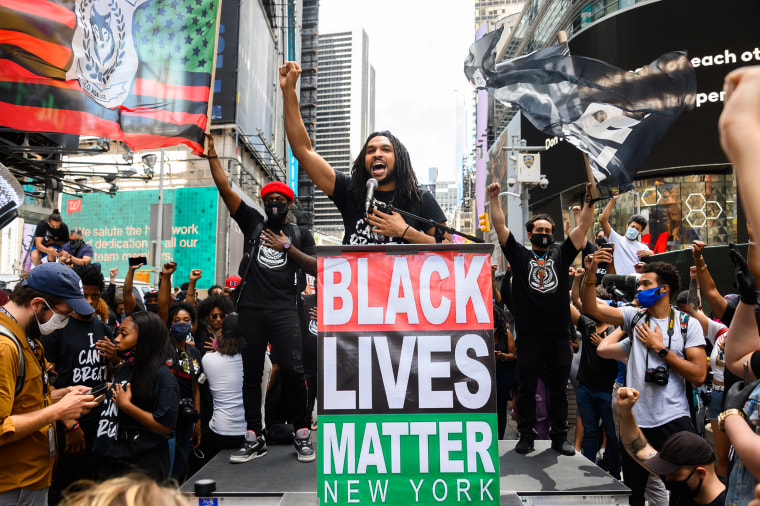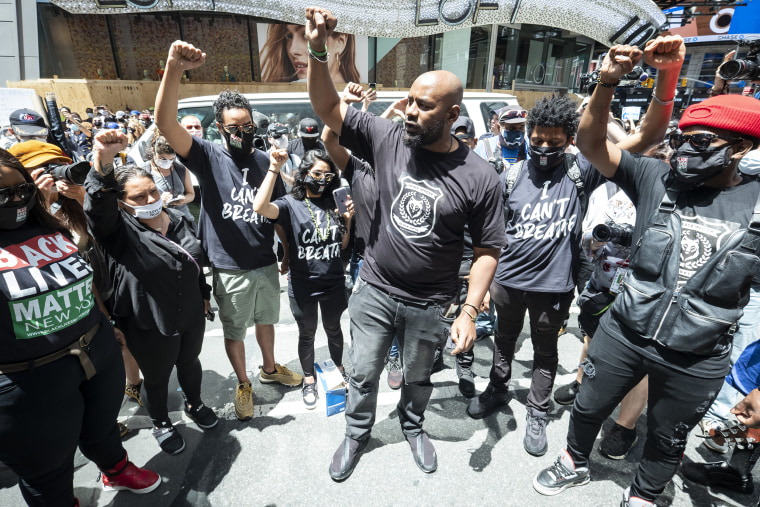Hawk Newsome, the co-founder of Black Lives Matter of Greater New York, paced in the center of a circle of about a dozen activists Sunday. Those in the group, which included representatives from several different city advocacy groups, raised their fists in the air. A crowd of thousands waited expectantly 10 yards away.
This, Newsome said, was their moment to define what comes next.
The organizers were gathered a few blocks from Times Square in Manhattan, where they had planned to rally before the New York City Police Department cut off their route. Many nodded as Newsome lamented “activism tourists,” describing those who had stepped in and out of the movement since Eric Garner died in 2014, pleading for his life while a police officer held him in a chokehold.
“Everyone in this circle has stayed the course,” said Newsome, one of the most bellicose and public-facing Black organizers in the nation. “So now that the whole world is marching, it is our opportunity and our obligation to give them a plan — to give them demands.”
Newsome’s pump-up speech served as a precursor to a two-hour event that included speeches from academics, poets, organizers, musicians, social media influencers and a candidate for Congress, most of whom appeared to be in their early 20s. The actor and comedian Nick Cannon declared that he was “ready to put my life on the line for my people.”
But the focus of the event was its conclusion: a list of 24 policies and reforms, known as “The Blueprint,” that Black Lives Matter expects New York City and the state to incorporate. The reforms, which include everything from the “I Can’t Breathe” Act and disbanding police unions to education equity, affordable housing and reparations, were catalyzed in part by the sweeping backlash over the police custody death of George Floyd in Minneapolis.
The aims are to investigate police and invest in communities of color.
“We now have all 50 states paying attention,” Chelsea Miller, the founder of Freedom March NYC, said. “So now the question is how do we push even further past conversations about the police’s use of chokeholds and think about the system as a whole.”
Beyond providing a list of policies, the four-page document appears to have helped consolidate multiple New York protest organizations, led by young people, under a banner as they push for long-term political and policy changes.
There are numerous groups working across the city, many with similar policy goals but separate plans on how to achieve them.

“We’re trying to make sure we’re all on the same page,” said Joseph Martinez, a member of Warriors in the Garden, a college-age group in which he has focused on political and policy goals. “We’re all fighting for the same thing: We have different ideas about how to get there, but we’re always in contact and telling each other what we’re doing.”
The efforts of the numerous groups are generally concerted, said Martinez, who was recently arrested by the NYPD while protesting, but many organizations have shared their intention to submit their own proposals beyond “The Blueprint” provided by Black Lives Matter of Greater New York.
Full coverage of George Floyd’s death and protests around the country
Still many are working together to support candidates for office, educate marchers on policy, begin voter registration drives, raise money for personal protective equipment to protect against the pandemic, and meeting with each other and local politicians to navigate a way forward.
“We understand that we’re going to be here for a while, and so we really want to take this opportunity to create a world that is more in line with our goals,” said Carlos Polanco, a Dartmouth University student at the rally who works with Black Lives Matter and has helped lead a number of protests. “We believe in a world without police and mass incarceration, and so we’re trying to show, not just the number of people protesting, but also create a model of what our future can look like.”
‘This isn’t a rally: This is a revolution.’
Protest organizers aim to harness the energy of the movement now in New York City and create change at the local, state and national levels. While thousands have taken to the streets each day for two weeks under their young leadership, they are clear-eyed that marches alone won’t bring long-term sustained change.
Since the protests began, they successfully brought major New York City roadways to a standstill with a crush of people standing shoulder-to-shoulder. Organizers still have numerous political goals: getting people of color into positions of power — city councils, state legislatures and Congress — as well as removing President Donald Trump from office and replacing New York City Mayor Bill de Blasio either through his resignation or the election in 2021.
“The whole country is fighting white supremacy,” said Vidal Guzman, who has led marches and works as an organizer. “There’re three pillars to that: getting Trump out of office, reporting and locking up officers who are killing people, and then pulling together a policy package on the state and local level.”
The frustration with government inaction — especially from a mayor who appealed to communities of color — runs deep in the Black activist community in New York City, where many feel as though they receive lip service and performative gestures at most and only when there is clear pressure.
This week, many pointed to the mayor’s announcement that he would paint “Black Lives Matter” on one street in each of the boroughs. This stands in contrast to his lackluster response to the NYPD’s recent use of force against protesters or the long-term issues that organizers have seen within city and state governments.
In the past two weeks alone, as marches have gained steam, organizers also point to the mayor’s defense of the police when they penned protesters on the Manhattan Bridge for hours, the use of excessive force, like when an NYPD vehicle drove into a crowd of protesters, or the police’s removal of masks from those they arrest before putting them in crowded holding cells.

It’s this type of leadership that caused Chivona Newsome to mount a congressional campaign in the Bronx, she said. Newsome, Hawk’s sister and also a co-founder of Black Lives Matter of Greater New York, said politicians have the ability to make changes immediately if they choose to address the issues.
Chivona Newsome, who told the crowd Sunday that “This isn’t a rally: This is a revolution,” said that it shouldn’t take being elected to bring these concepts to policymakers.
“Legislation is the most important thing to protect our people, to get the justice that we want, because without it, we will be denied,” Newsome said. “The policies we’re introducing are not what I’m promising once I get to Congress in January 2021, they’re what we’re demanding from people who are in office now.”
Educating a new group of protesters
Organizers realize that the adoption of these reforms will require educating the “activism tourists” that Hawk Newsome lamented.
Warriors in the Garden, the group organized by college students in New York City, said it is actively working to register those at its protests to vote, holding marches explicitly designed for school-aged children and their parents and expanding a digital campaign via Instagram and TikTok to engage younger people and educate them about the issues. In time, they plan to endorse candidates and are focused on emphasizing the importance of local elections.
Education, multiple members of the group said, is key to undermining systemic racism and oppression, particularly if they want to make the next generation better.
Download the NBC News app for full coverage and alerts on this story
“We have the kids at the end of the day,” said Livia Rose Johnson, 20, a marketing student at Sarah Lawrence College who is helping lead the Warriors. “Gen-Z is listening, and we recognize that. So while we are sending people to do marches today, the big pivot is from protests on the streets to digital protesting. We want to get louder than the same 5,000 to 10,000 people we have marching every day.”
But some organizers are also attempting to force the city to reckon with its values in physical ways, as well. The hope is that changing the physical shape of New York City and its prominent monuments will cause people to educate themselves.
In 2017, Glenn Cantave began asking New York City to reexamine its monuments, specifically ones with ties to white supremacy or violence against communities of color. Cantave, the head of Movers and Shakers NYC, said his pleas fell on deaf ears — even his specific request about the statue of Christopher Columbus in Manhattan’s Columbus Circle.

Amid the demonstrations, he said, it’s hard to ignore that protesters have beheaded a statue of Columbus in Boston and a group in Richmond tore down another sculpture before throwing it into a lake.
Feeling ignored by the city government, Cantave is using the digital space to educate future organizers and communities of color about their own history.
He is now in the late stages of developing an app that creates digital models of Black and brown heroes of history to help teach kids at home, an activity he pursues between helping organize street protests and raising money to buy personal protective equipment to safeguard protesters against the coronavirus.
“This is a work around because these institutions are refusing to highlight those narratives,” said Cantave, who has helped pass out 10,000 KN95 masks across the five boroughs this past week. “This allows people to do it at home, transform your space into a learning space and make it fun.”
“But this isn’t about optics,” he added, “this is about power and getting the information in people's heads, so they think differently when they go vote.”

